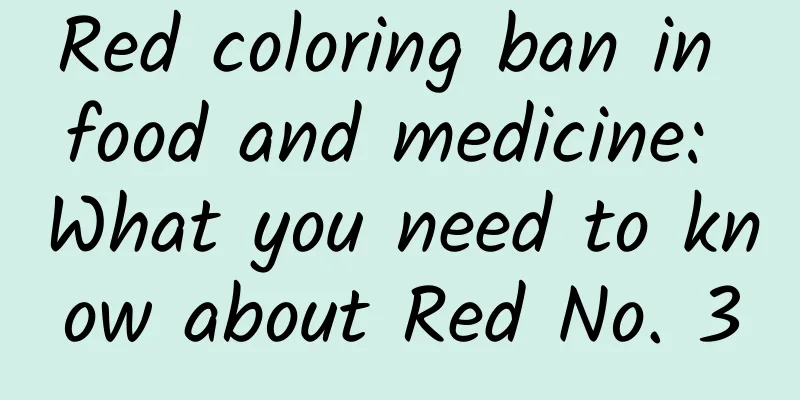Red coloring ban in food and medicine: What you need to know about Red No. 3

|
Author: Huang Yanhong Duan Yuechu In our daily lives, the safety of food and drugs has always been a topic of great concern. Recently, the U.S. Food and Drug Administration (FDA) made an important decision on the use of red pigments in food and drugs, which has aroused widespread attention and discussion. This decision is closely related to our health. Let us take a deeper look at the mystery. The U.S. Food and Drug Administration (FDA) recently revoked authorization for the use of Red No. 3, a synthetic dye derived from petroleum, in all foods and internal medicines. The ban was in response to a petition filed in 2022 by the Center for Science in the Public Interest and other advocacy groups. Red No. 3, a cherry-red colorant, is not uncommon in our lives. In the food field, it may be found in candies, maraschino cherries, strawberry-flavored milk drinks, etc. In medicine, it can also be found in some cough syrups. However, manufacturers of food and oral medicines have until January 15, 2027 and January 18, 2028, respectively, to remove this dye from their products. In laboratory studies, male rats developed thyroid tumors after being exposed to high doses of Red No. 3. However, the FDA noted that the rats developed cancer through a hormonal mechanism that does not occur in humans, and that studies in humans and other animals have not shown similar effects. Nevertheless, under the Delaney clause of the Federal Food, Drug, and Cosmetic Act, the FDA prohibits the use of a food or color additive if it is found to cause cancer in humans or animals, and Red No. 3 was removed. There are also concerns about other artificial dyes, including another red dye, Red No. 40, because studies have shown that these dyes may cause behavioral problems such as hyperactivity in children. In fact, the FDA has banned the use of Red No. 3 in cosmetics and topical medications since 1990. The European Union banned its use in food (with the exception of cocktail cherries) in 1994, and California followed suit in 2023. “The FDA has a very broad mandate, and they focus primarily on drugs,” said Sheela Sathyanarayana, professor of pediatrics and adjunct professor of environmental and occupational health sciences at the University of Washington and Seattle Children’s Research Institute. “With food, the focus is primarily on food safety, especially infectious diseases like E. coli. But there are gaps and gaps when it comes to food safety issues related to food additives, environmental exposures and contaminants.” However, under the Biden administration, the FDA recently established a new Office of Food Chemical Safety. “I’m hopeful that with the establishment of this new office, they will be able to evaluate a variety of different exposure scenarios, from food additives to contaminants, in a more comprehensive way,” Sathyanarayana said. The doses of Red No. 3 that rats were exposed to in the study were likely far higher than humans would normally consume. But determining toxic doses for humans is difficult because it’s unethical to run randomized controlled trials that feed people large amounts of food containing certain additives. Most human studies of food ingredients are epidemiological, which involve asking people to recall what they ate and how much, a notoriously unreliable approach. Melinda Ring, a physician and director of the Osher Center for Integrative Health at Northwestern University Feinberg School of Medicine, noted that the upper acceptable daily intake of Red No. 3 is 0.1 mg per kilogram of body weight per day. "For example, at typical concentrations, this is roughly equivalent to a child eating 12 red gummy bears and an adult eating 36. However, studies have shown that cumulative exposure to toxins can have an additive effect, so it is safer to avoid synthetic dyes altogether than to consume 'tolerable' amounts." Red No. 3 may be one of the most studied dyes, but other dyes, such as Red No. 40, have also been linked to health problems. Some studies have linked red dye to an increased risk of behavioral disorders, such as ADHD. Now that Red No. 3 has been banned, it will be interesting to see whether the FDA bans some of the other dyes, said Tracy Crane, associate professor of medical oncology at the Sylvester Comprehensive Cancer Center at the University of Miami Miller School of Medicine. In general, it’s best to avoid consuming or taking large amounts of foods or medications that contain artificial colors. “I always tell people to eat less,” Crane says. “I tell people, ‘Try not to put anything synthetic in your body. If the color isn’t natural, it’s probably synthetic.’” There are actually safer natural alternatives, like coloring made from beets, carrots, and even insects. Foods with artificial colors often use bright, cheerful colors to attract children, which is a problem. "We need to change our expectations of what food should look like," Crane said. And it's not just artificial colors that can be harmful: Many foods that contain these colors also contain high amounts of added sugar. "From a cancer prevention perspective, it is recommended that added sugars be consumed at less than 10% of total calories," Hannah Manella, a registered dietitian at Northwestern Medicine, wrote in an emailed statement to Scientific American. In addition, many of these foods are ultra-processed, which some studies have linked to various diseases or health problems. "Choosing whole, unprocessed foods or reading ingredient labels carefully can help consumers reduce their exposure to synthetic dyes and other environmental toxins while supporting a cleaner, safer food supply," Ring said. The ban of Red No. 3 in food and medicine has sounded the alarm for us, reminding us to pay attention to various additives in food and medicine. When choosing food and medicine, we should be more cautious and try to choose natural and healthy products to protect the health of ourselves and our families. Reference: “What to Know about the Ban on Red Dye in Foods and Drugs”, author Tanya Lewis, published in Scientific American, published on January 16, 2025. |
<<: Ultra-processed foods: The health risks behind delicious food
Recommend
What is the difference between sunscreen and lotion?
In modern life, people's living standards hav...
How many days does it take for breast engorgement to disappear after induced labor?
Every expectant mother and father is looking forw...
The harm of smoking for women
As work pressure increases, many female friends l...
What are the health-preserving soups for women in summer?
The hot summer always brings great troubles to pe...
Female pubic hair trimming is good for health, please pay attention to these matters
The pubic area is a relatively private part, and ...
Do you know how important your pelvic floor muscles are?
Do you have any of these symptoms? Leaking urine ...
Inheriting light and dedicating love: Here’s what you need to know about corneal donation
Corneal donation is a great act of kindness that ...
How to prevent recurrence of urinary tract infection in women
Urinary tract infection is a common, easy-to-occu...
Can I have an abortion at 50 days of pregnancy?
Sometimes, unplanned pregnancies occur due to del...
Is progesterone 22 normal?
Is it normal to have a progesterone value of 22 i...
Diet after breast cancer surgery: a reasonable diet is crucial
Breast cancer is a relatively common malignant tu...
How to put on makeup well? Just remember these methods
If you are sure to put on makeup, you must first ...
What to eat for beauty and anti-aging
Beauty and skin care have always been the most im...
Can I still get pregnant even with a condom?
For a normal relationship between a man and a wom...
Is it normal to have itchy vagina during menstruation?
Women experience itching down there during menstr...









